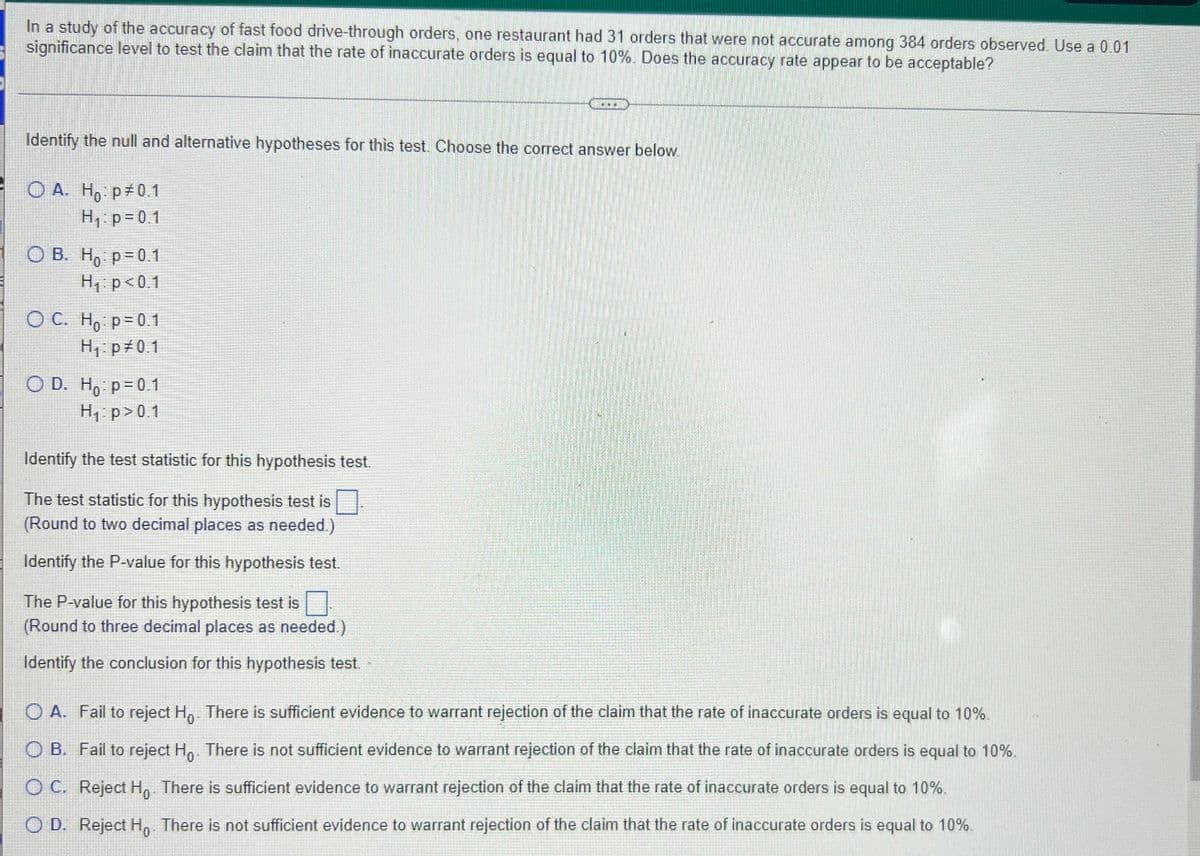In a study of the accuracy of fast food drive-through orders, one restaurant had 31 orders that were not accurate among 384 orders observed. Use a 0.01 significance level to test the claim that the rate of inaccurate orders is equal to 10%. Does the accuracy rate appear to be acceptable? ... Identify the null and alternative hypotheses for this test. Choose the correct answer below. OA. Ho: p *0.1 H₁: p=0.1 OB. Ho: p=0.1 H₁: p<0.1 OC. Ho: p=0.1 H₁: p=0.1 O D. Ho: p=0.1 H₁: p>0.1 Identify the test statistic for this hypothesis test. The test statistic for this hypothesis test is (Round to two decimal places as needed.) Identify the P-value for this hypothesis test. The P-value for this hypothesis test is (Round to three decimal places as needed.) Identify the conclusion for this hypothesis test. O A. Fail to reject Ho. There is sufficient evidence to warrant rejection of the claim that the rate of inaccurate orders is equal to 10%. OB. Fail to reject Ho. There is not sufficient evidence to warrant rejection of the claim that the rate of inaccurate orders is equal to 10%. OC. Reject Ho. There is sufficient evidence to warrant rejection of the claim that the rate of inaccurate orders is equal to 10%. O D. Reject Ho. There is not sufficient evidence to warrant rejection of the claim that the rate of inaccurate orders is equal to 10%.
In a study of the accuracy of fast food drive-through orders, one restaurant had 31 orders that were not accurate among 384 orders observed. Use a 0.01 significance level to test the claim that the rate of inaccurate orders is equal to 10%. Does the accuracy rate appear to be acceptable? ... Identify the null and alternative hypotheses for this test. Choose the correct answer below. OA. Ho: p *0.1 H₁: p=0.1 OB. Ho: p=0.1 H₁: p<0.1 OC. Ho: p=0.1 H₁: p=0.1 O D. Ho: p=0.1 H₁: p>0.1 Identify the test statistic for this hypothesis test. The test statistic for this hypothesis test is (Round to two decimal places as needed.) Identify the P-value for this hypothesis test. The P-value for this hypothesis test is (Round to three decimal places as needed.) Identify the conclusion for this hypothesis test. O A. Fail to reject Ho. There is sufficient evidence to warrant rejection of the claim that the rate of inaccurate orders is equal to 10%. OB. Fail to reject Ho. There is not sufficient evidence to warrant rejection of the claim that the rate of inaccurate orders is equal to 10%. OC. Reject Ho. There is sufficient evidence to warrant rejection of the claim that the rate of inaccurate orders is equal to 10%. O D. Reject Ho. There is not sufficient evidence to warrant rejection of the claim that the rate of inaccurate orders is equal to 10%.
MATLAB: An Introduction with Applications
6th Edition
ISBN:9781119256830
Author:Amos Gilat
Publisher:Amos Gilat
Chapter1: Starting With Matlab
Section: Chapter Questions
Problem 1P
Related questions
Question

Transcribed Image Text:In a study of the accuracy of fast food drive-through orders, one restaurant had 31 orders that were not accurate among 384 orders observed. Use a 0.01
significance level to test the claim that the rate of inaccurate orders is equal to 10%. Does the accuracy rate appear to be acceptable?
COD
Identify the null and alternative hypotheses for this test. Choose the correct answer below.
O A. Ho: p0.1
H₁: p=0.1
O B. Ho: p=0.1
H₁: p<0.1
O C. Ho: p=0.1
H₁: p‡0.1
O D. Ho: p = 0.1
H₁: p > 0.1
Identify the test statistic for this hypothesis test.
The test statistic for this hypothesis test is
(Round to two decimal places as needed.)
Identify the P-value for this hypothesis test.
The P-value for this hypothesis test is
(Round to three decimal places as needed.)
Identify the conclusion for this hypothesis test.
O A. Fail to reject Ho. There is sufficient evidence to warrant rejection of the claim that the rate of inaccurate orders is equal to 10%.
O B. Fail to reject Ho. There is not sufficient evidence to warrant rejection of the claim that the rate of inaccurate orders is equal to 10%
O C. Reject Ho. There is sufficient evidence to warrant rejection of the claim that the rate of inaccurate orders is equal to 10%.
OD. Reject Ho. There is not sufficient evidence to warrant rejection of the claim that the rate of inaccurate orders is equal to 10%.
Expert Solution
This question has been solved!
Explore an expertly crafted, step-by-step solution for a thorough understanding of key concepts.
This is a popular solution!
Trending now
This is a popular solution!
Step by step
Solved in 2 steps with 1 images

Recommended textbooks for you

MATLAB: An Introduction with Applications
Statistics
ISBN:
9781119256830
Author:
Amos Gilat
Publisher:
John Wiley & Sons Inc

Probability and Statistics for Engineering and th…
Statistics
ISBN:
9781305251809
Author:
Jay L. Devore
Publisher:
Cengage Learning

Statistics for The Behavioral Sciences (MindTap C…
Statistics
ISBN:
9781305504912
Author:
Frederick J Gravetter, Larry B. Wallnau
Publisher:
Cengage Learning

MATLAB: An Introduction with Applications
Statistics
ISBN:
9781119256830
Author:
Amos Gilat
Publisher:
John Wiley & Sons Inc

Probability and Statistics for Engineering and th…
Statistics
ISBN:
9781305251809
Author:
Jay L. Devore
Publisher:
Cengage Learning

Statistics for The Behavioral Sciences (MindTap C…
Statistics
ISBN:
9781305504912
Author:
Frederick J Gravetter, Larry B. Wallnau
Publisher:
Cengage Learning

Elementary Statistics: Picturing the World (7th E…
Statistics
ISBN:
9780134683416
Author:
Ron Larson, Betsy Farber
Publisher:
PEARSON

The Basic Practice of Statistics
Statistics
ISBN:
9781319042578
Author:
David S. Moore, William I. Notz, Michael A. Fligner
Publisher:
W. H. Freeman

Introduction to the Practice of Statistics
Statistics
ISBN:
9781319013387
Author:
David S. Moore, George P. McCabe, Bruce A. Craig
Publisher:
W. H. Freeman